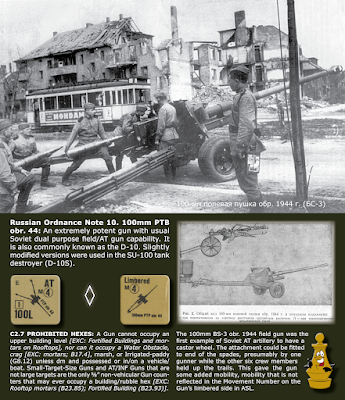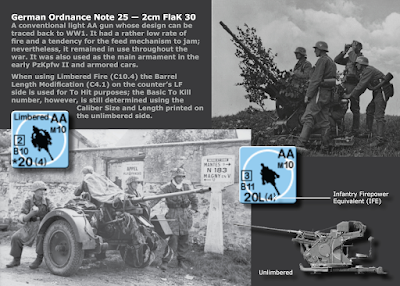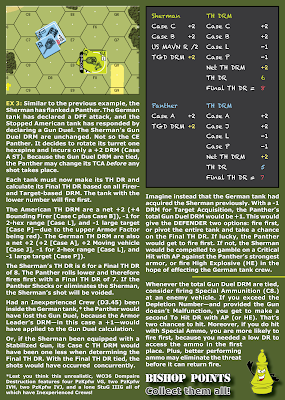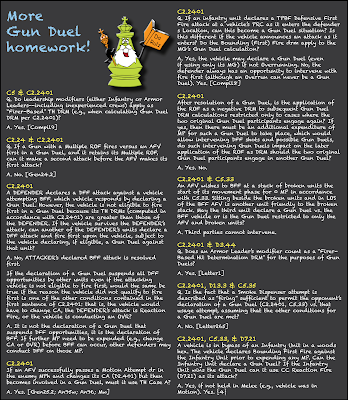Part of the problem is deciding where to site this powerful weapon. Although it beggars belief, you can actually position this monstrosity inside a building! Despite weighing 4 US tons and having a Manhandling number (M#) of 4, the D-10 is inexplicably not a large target. And because ASL classifies it as an anti-tank (AT) Gun (C2.22), the D-10 meets the requirements of C2.7, allowing it to set up at ground level in a building. Contrast this with the smaller 85mm obr. 44 (Russian Ordnance Note 17), which is classified as an artillery (ART) Gun and is therefore prohibited from setting up in a building, unless Fortified (B23.9).fn1 More on Fortified Buildings later.
Placing my 100mm tank-buster in a (stone) building seems like a no-brainer. Aside from the beneficial Terrain Effects Modifier (TEM)—equivalent to or better than Emplacement TEM (C11.2), buildings tend to discourage Overruns (OVR) due to the risks of Bog (D8.2) and falling into a cellar (B23.41). The latter would be an ignominious end for a Tiger, royal or not. To be fair, woods discourage OVR too. So why bother with brush, grain or orchard, for example? Granted my Gun can set up hidden and Emplaced in these types of Concealment Terrain, but it seems awfully vulnerable to OVR. While certainly true, there is another consideration that be even more important: the ability to fire and hit an enemy vehicle before it can ruin my day.
 |
| 100mm PTB obr. 44 |
Having agonized over where to place my ginormous can opener, my cunning opponent will typically approach from outside the weapon’s Covered Arc (CA). This sly move has the effect of penalizing any shot I might take due to the application of the Case A To Hit Dice Roll Modifier (DRM) of +3 for changing CA (C5.1). If I was “clever” enough to set up in a building, rubble, or woods, the Case A DRM would be doubled (C5.11). It gets worse.
When a (non-vehicular) non-turreted (NT) Gun changes its CA to fire, any multiple Rate of Fire (ROF) capability it may have is lowered by one for its next shot (C2.29). There are exceptions to this Conditional ROF rule; we’ll deal with them shortly. In practical terms, this amounts to my big Gun having no ROF because its printed ROF is 1. In other words, should I miss with the first shot—the most likely outcome—any second shot would be as Intensive Fire (C5.6). On the plus side, Case A may no longer apply, while target Acquisition (C6.51) would. But the risk of malfunction (C5.62) just tripled!
It gets decidedly dire if your Gun has no ROF to lower. Consider the mighty 15cm sIG33 infantry (INF) Gun below. Should it change CA to fire, it is thereafter marked with an Intensive Fire counter, even if it did not use Intensive Fire for that shot. The counter serves to remind players that the Gun may not use Intensive Fire for the remainder of that player turn. The lone exception is OVR Prevention (C5.64).
 |
| 150mm sIG 33 |
One takeaway is that if your Gun has virtually no prospect of a second shot after changing CA, it may be better to avoid setting it up in a building, rubble or woods where your one and only shot could be subject to the doubling of Case A. But what about a Gun with a ROF of 2 or more? Is there any advantage to be gained from setting up in anti-OVR terrain? There could be.
An AT Gun, such as the 37mm M3A1 below, has a one-in-six chance of maintaining ROF if it changes CA to fire. The German PaK 35/36, on which the American gun was based, has one chance in three. In both cases, however, this lowered ROF is temporary. Should either Gun maintain ROF, its printed ROF would apply to any subsequent shots. For example, if the M3A1 were to maintain ROF after changing CA to fire, by rolling a 1 on the colored die roll (dr), its ROF for any follow-up shot would be 2. Unless the Gun changed CA for this shot too, in which case, Conditional ROF would apply again.
 |
| 37mm M3A1 |
It is a trade off. In return for better protective terrain, the M3A1 has lower odds of maintaining ROF on the shot taken immediately after changing CA. But unlike a Gun with a ROF of 1, or no ROF at all, at least there is a chance that it will maintain ROF. Moreover, should the M3A1 maintain ROF, its normal ROF is restored for any subsequent shots. You can try your hand at this in Bill Sisler’s AP115 “Bats Outta Hell.”
There is another, seldom used option that favours setting a Gun up in +3 TEM or better—a stone Fortified Building Location comes to mind. Assuming that your Gun is allowed to set up in a building—note that all Guns are permitted to set up in the ground level of a Fortified Building (B23.93)—you may want to change CA and defer firing to a later phase. Before you get too excited, the option of changing CA without firing at the end of a friendly fire phase excludes the Movement Phase (MPh). Rule C3.22, however, does allow a Gun to change CA in its Prep Fire Phase (PFPh), for example, and fire in the Advancing Fire Phase (AFPh) without any Case A DRM applying due to the CA change in the PFPh. Equally important is that Conditional ROF is not applicable (NA) either. A careful reading of C2.5 reveals that ROF is only lowered if the shot takes place in the same, or current, phase as the CA change does.
 |
| 76mm LK/13 |
The tactic works best when your Gun and crew are in terrain that allows them to weather a Defensive-Fire storm. Due to its small target size, the Finnish artillery piece above may set up in a building. It could even set up in a fortified upper building level! Like the M3A1 AT Gun, the LK/13 ART Gun retains the possibility of maintaining ROF if it changes CA and fires in the same phase. But in the latter case, the Finnish player is left with a more difficult choice should the Gun fail to maintain ROF after changing CA. To Intensive Fire or not to Intensive Fire? Because the printed Breakdown Number (B#) of an LK/13 is 11, Intensive Fire becomes a greater gamble when this B# is lowered by two (A.11). Fire at your own risk!
Alternatively, the LK/13 could change CA at the end of the PFPh, DFPh, or AFPh provided it remains capable of firing without having to resort to Intensive Fire (C3.22). Clearly, this precludes any further fire in the phase in which the CA is changed. So unless you are trying to set up a better shot for next turn, changing CA in the PFPh is the only practical way to have your unconditional cake and eat it. Bear in mind that the Gun would be subject to the Case B +2 DRM (+3 if in building/rubble/woods per C5.2) for fire in the AFPh. Case A usually would not, because as C5.12 tells us, “the Case A DRM is applicable only to a Gun which made a CA change as part of its shot.” Negating the Case A To Hit DRM can be a big deal when your badass Gun is inside a building, rubble, or woods.fn2
Less clear is the last sentence of C3.22: "Such a change in the PFPh cancels any movement possibilities for that Gun (even a vehicular Gun) and its crew for the rest of that Player Turn, but does not prevent that Gun from attacking in the AFPh—presumably without any Case A DRM." This suggests that the LK/13 is not prohibited from firing in the PFPh. Provided the Gun maintains ROF, the crew could opt to change CA at the end of the PFPh. This slick move would give the Gun a single shot in the AFPh. Again Case B would apply, but Case A would not (unless the Gun changed CA in the AFPh). I'm not convinced that this is permissible. It contradicts the basic premise of A3.5, which tells us that units that did not fire in the PFPh, may fire in the AFPh (see also, A7.1). (Although D3.22 allows for the possibility that a vehicle with a Multiple ROF weapon may fire in both its MPh and its AFPh, this exceptional form of Advancing Fire does not violate A3.5.)
Now let me turn to the exceptions, examples where Conditional ROF will not apply but where Case A may. Take for instance support weapons (SW) such as anti-tank rifles (ATR), SW infantry guns (INF), and SW recoilless rifles (RCL) that use the To Hit process. Unlike a Gun, which is depicted on a ⅝” counter and always has a defined CA (C3.2), a (non-inherent) SW is depicted on a ½” counter (C2.1) and normally has an unrestricted field of fire. Nevertheless, in certain situations that are similar to Guns, a 20L ATR, a SW INF, or a SW RCL can have a “fixed CA.” A restricted CA applies to these weapons should they fire from a building, rubble, or woods Location. These SW differ from their bigger brethren in that any fixed CA is temporary, limited to the duration of the fire phase in which they fired (A9.21). Moreover, neither Conditional ROF nor the Case A To Hit DRM ever apply to these or any other SW for that matter.
 |
| 20mm Solothurn s18-1100 |
 |
| 37mm Canon de 37 mle 16 TR |
 |
| 57mm M18 Recoilless Rifle |
A light mortar (MTR) likewise has no CA. Light mortars are those mortars with a calibre of 60mm or less. Depicted on ½” counters, they are never subject to a fixed CA or to Case A when they fire, regardless of the terrain that they occupy. (Granted mortars usually cannot fire at all if they are inside a building.)
 |
| 50mm Lance-Grenades de mle 37 |
Medium mortars, those typically with a calibre between 76mm and 82mm, are a different animal. On the one hand, they are treated as other Guns with regard to the application of Case A. On the other hand, they are exempt from Conditional ROF. That bears restating given that these weapons tend to have a ROF of 3. Remind yourself of that the next time you attempt to outflank a medium mortar, even one in restrictive terrain.
 |
| 81mm Savunheitin M/42 |
Conditional ROF therefore does not apply to SW or to medium mortars. This condition nonetheless applies to every other Gun that is not turreted. That leaves turreted Guns.
Anti-aircraft (AA) Guns immediately spring to mind. In order to target overflying aircraft almost all AA guns had a 360° mount. This capability is indicated in ASL by a large white circle around a Gun’s artwork (C2.3). In game terms, this means that a turreted Gun is treated the same as a vehicular Gun with Fast Turret Traverse (D1.31), known as a “T” Type weapon. This form of mount is advantageous for two reasons: Conditional ROF is NA and the Case A DRM for changing CA is +1. Case A is still doubled if the Gun is in a building, rubble, or woods. I think you will agree that a +2 DRM is so much better than a +6 DRM.
Before they can be moved, some Guns need to be limbered, converted from their primary firing state into something more compact or suitable for transit. A select group of these weapons platforms are allowed to use Limbered Fire (LF), provided they are not currently hooked up to a towing vehicle (C10.24). Due to their AA role, some models not only retain their ability to fire when limbered, as shown by the presence of a Gun Calibre Size on their limbered side, but also their turreted status. Consequently, they remain exempt from Conditional ROF even when using LF, as is the case with most Bofors AA Guns.
 |
| 75mm Bofors M29 |
The last sentence of C2.3 is easily overlooked. It tells us that “T types are further classified into various sub-groups (D1.3).” The only other sub-group that matters to us though is the Slow Turret Traverse (ST) category (D1.32), symbolized by a large, thin white square bordering the Gun’s silhouette. Admittedly, there are not many examples in the standard ASL counter mix. For instance, the Slovak 83.5mm Kanon PL vz. 22/24 below is unusual for an AA Gun in having Slow Traverse. Pity there are no scenarios where you can put this knowledge to use. You will have a little more luck with the Belgian 75mm FRC M27. Another slow-traverse AA Gun, it is featured in FrF86 “Belgian Tigers” from Friendly Fire Pack 11 [2017] (available in our KitShop).
 |
| 83.5mm Kanon PL vz. 22/24 and 75mm FRC M27 |
The AT version of the soixante-quinze, the famed French 75, is remarkable for having an “after-market” 360° firing table, albeit one with slow traverse. Not so the British 2-Pounder, which was designed to have a 360° field of fire and a fast traverse. Careful with these AT Guns, however. The reverse side of these counters reveals a limbered state that permits firing while limbered, but only as NT Guns. Translation: any Limbered Fire by these Guns is subject to Conditional ROF. The golden oldie “Khamsin” provides a target-rich environment for the 2-Pounder. The more recent J186 “Castles on the Horizon” is a similarly inviting firing range for this “pop gun.”
 |
| 40mm OQF 2-Pounder |
 |
| 75mm Canon de 75 Antichar mle 97/35 |
It is understandable why an AT gun, especially a small calibre one, might be designed for 360° fire. It is less obvious why an artillery piece, usually one sited far behind the front lines, would benefit from the extra weight of a firing table. Perhaps the most common example is the British 25-Pounder. Due to the lack of effective AT assets following the fall of France, the 25-Pounder was pressed into service as an expedient AT gun, especially in North Africa. The firing table allowed the gun to track and engage moving enemy vehicles more effectively. Scenario 58 “Ci Arrendiamo” is a good demonstration of this tactical imperative. The 25-Pounder also plays a starring role in AP150 “Norwegian Edelweiss” together with some helpful Swedish Volunteers. A lesser known scenario, OA5 “Rear Area Defenders,” pits another pair of 25-Pounders against enemy tanks and halftracks in May 1940. If you set these guns up well to begin with, there should be no need to ever move and therefore limber them. And as long as they remain unlimbered, Conditional ROF will not apply to your dual-purpose artillery.
 |
| 88mm OQF 25-Pounder |
A more fascinating artillery design is the Skoda 8cm Kanon vz. 28, or Model 1928. Manufactured in Czechoslovakia and based on an earlier mountain gun, it was intended to be an artillery version of the Swiss army knife. Not only would the M28 function as a mountain gun, a field gun, and a stop-gap AT gun, it was also intended to serve as an AA gun. It was short lived. Czechoslovakia’s army purchased a limited number of the vz 28, but it was soon superseded by the improved vz 30, which lacked the earlier design’s firing table for AA fire. With the demise of Czechoslovakia in March 1939, these guns fell into German hands. In Wehrmacht service, the vz 30 were given the designation 8cm FK 30(t), reinforcing the mistaken idea that these guns used 80mm ammunition. (As far as I know, this size of artillery round has not been used since the 19th century.) The 8cm gun actually fired a 7.65cm round. Germany redistributed a number of the 8cm Kanon vz 28 to her allies, the newly constituted, quasi-independent states of Croatia and Slovakia. In ASL, the 8cm vz 28 is treated as an 80mm artillery piece referred to as the Skoda M28(80). “Retrained and Rearmed” from ASL Action Pack 5 has two of these in the Slovak order of battle (OB).
During the 1930s, Skoda exported a number of vz 28 to Yugoslavia. One source I found claimed that the Yugoslav army took delivery of 136 75mm vz 28 mountain guns, and 300 8cm vz 30 field guns. The former appears to be the closest fit for what ASL calls the 80mm M28/M33 (Yugoslavian Ordnance Note 21). Apart from the lack of a firing table, these guns also differ from the Axis Minor M28(80) in having limited Smoke capability. It is revealing that when the Germans captured the longer-barrelled 8cm vz 30 field guns in Yugoslavia, they redesignated them as 7.65cm FK 304(j). (See the slide below for more background on the Skoda M28.) The True calibre aside, the main difference for our discussion is that, of the various Skoda M28 in ASL, only the Skoda M28(80) is exempt from the restrictions of Conditional ROF.
%20and%20M28:M33.jpg) |
| 80mm Skoda M28 |
There are some other not-so rare rarities worth taking a look at such as German recoilless rifles, and the 7.5cm Leichtgeschütz 40 in particular. With a ROF of “1,” it may not occur to some players to check for ROF given that Conditional ROF would normally reduce a Gun’s ROF to 0. I may have been guilty of this when playing FrF58 “Order 831” (from Friendly Fire Pack 7) on one or more occasions. The good news, from a practice perspective, is that there are almost two dozen scenarios where you can have a (back)blast with a 7.5cm LG 40. Among them are a couple of Primosole Bridge scenarios, including J96 "Another Bloody Attack."
 |
| 75mm Leichtgeschütz 40 |
The most unusual exception to the Conditional ROF rule is the Mortier de 7.6cm Allemand, or M76A for short. At the end of the Great War, the Belgians captured so many of these Minenwerfer—including heaps of ammunition for this bomb thrower—that two decades later they still had a surplus. The M76A is not notable for being exempt from C2.5 due to it being a medium mortar. Rather it is notable for being subject to these restrictions when limbered. This stems from the fact that the weapon was capable of Direct Fire: fire that requires a Line of Sight (LOS) from firer to the target (and that does not use Indirect Fire). However, Direct Fire is only permitted when the weapon is limbered. Indirect Fire (C.1), meanwhile, is only allowed when the weapon is unlimbered. The Gun classification on the counter changes to reflect this. On the unlimbered side it is a mortar (MTR); on the limbered side it is an infantry gun (INF).
 |
| 76mm M76A |
East Side Gamers published a scenario in 2005 that has a M76A in the Belgian OB. A Scenario Special Rule (SSR) in ESG4 “The Clog” allows the weapon to set up limbered at start. Doing so permits Direct Fire, but also invokes Conditional ROF. Fire at will!
Parting shot
Bill Sisler died last year. I do not claim to have known him. What little I did know of him, I gleaned from our brief interaction when Mark Nixon introduced him to me at an ASL Oktoberfest. Bill was an unassuming ambassador of the game. He struck me as inquisitive, genuine, and welcoming. He was also a prolific scenario designer, with more than 50 to his credit. And so I would like to close with an example from another scenario that Bill Sisler built, one that I have yet to play.
 |
| WO19 Japanese OB |
I cannot say when I will post again. I have been busy of late designing rather than playing scenarios. I would love to be able to come up with something as enduring as Bill Sisler’s “Le Hérisson,” of Croix de Guerre fame. Not likely. But one has to start somewhere. In the meantime, I leave you with a Coles Notes of Conditional ROF. Roll rate!
 |
| C2.5 Conditional ROF - Pawn Shop Talk |
Notes
1. An argument could be made that, like the 85mm obr. 44 (Russian Ordnance Note 17), the 100mm obr. 44 should be classified as an artillery (ART) Gun. Tellingly, the smaller calibre piece is a Quick Set-Up (QSU) Gun (C10.23), while the D-10 must be limbered before it can be pushed, towed, or hooked up (C10.2).
2. Opportunity Fire is an alternative. On the plus side, it allows for the possibility of Multiple ROF and Intensive Fire during the AFPh. The down side is that the Case A DRM and Conditional ROF would apply, because the Gun “cannot change its CA until actually resolving its To Hit attempt during the AFPh” (A7.25).
Special thanks to Juan, Ken, Thierry, and Tom.



















